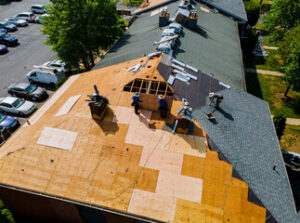If the roof is nearing or has passed its expected lifespan, it’s important to get a professional inspection. Damaged shingles or tiles and leaks, as indicated by water stains on walls or ceilings, are clear indicators of trouble.
A roofing professional will inspect the entire roof, including the fascia boards. They will check for signs of rot and mold growth. Contact Roof Repair Murfreesboro TN for professional help.
Missing shingles or tiles may not be visible from the ground, but they can cause leaks and other problems. It is important to fix them early before they worsen and spread. This will also prevent water damage to your interior and other areas of the home.
If you notice a shingle is missing or damaged, it is best to replace the entire shingle rather than just part of it. Otherwise, the rest of the shingle may not be as durable and could become vulnerable to further weathering or damage. This can lead to costly repairs in the future.
Start by checking whether you have any unused shingles or can purchase a bundle that closely matches your existing ones. You will also need a ladder and heavy-duty work gloves for safety. If you can’t climb the roof, it is recommended to hire a professional to do it for you.
Once you have the right materials, you can start repairing any damage. First, slide a pry bar under the damaged shingle and gently lift to release the sealer strip. Next, use the pry bar to lift the shingle above it and expose the roofing nails. Once the nails are exposed, remove them with a hammer claw and pull out the shingle.
Then, slide the new shingle into place and align it with the surrounding ones. Secure it with roofing nails and apply roofing cement to ensure a tight fit. Finally, inspect and apply caulk around any protrusions in the roof such as air conditioning vents, chimneys, and other features. This will help to keep moisture from seeping into the roof and causing further damage.
Shingles are more vulnerable to hail damage than tile roofs, but a timely repair will protect it from further damage. Inspect your shingles regularly and replace them when necessary, especially after storms.
Leaks
It’s a familiar scene: a heavy rainstorm comes along and you’re running around the house placing pots and pans under water stains on the ceiling. If you’ve spotted this scenario playing out in your home, then there is probably a leak somewhere in your roof that needs to be fixed.
Leaks can often be tricky to locate. If you’re lucky, the water stain on your ceiling or down your walls is directly underneath where the problem is located on the roof. Otherwise, gravity pulls the water down and across beams or insulation before it eventually shows up indoors as a stain. So, if you notice water stains on the ceiling or walls, go into your attic and look upwards to see where it’s coming from. The point where the water begins may not be directly under the trouble spot on the roof; it could be a long way down or on the other side of the roof!
Some common sources of leaks are:
Chimneys or flues: if the flashing isn’t properly sealed or if it is cracked or damaged, this is a potential leak source. Skylights: if the seal is broken or if there are cracks in the pane, this is also a potential leak point. Vents: roof vents, exhaust fans, and satellite dishes can all allow water in if their seals are worn or the metal flashing is loose or missing.
Keeping a log of when, where and how much water is entering the building can help identify the source of a leak. It will also help you prove the cause of the leak to a roofing contractor, architect, or construction company should an issue arise.
Prioritize safety when doing roof repairs: wet shingles are slippery and a fall can be disastrous. Always wear shoes with good traction, climb only on safe, sturdy ladders and never go up alone. You should also consider using a Personal Fall Arrest System or a fixed Fall Restraint System when working on a steep or high-pitched roof, and have someone on the ground to assist in case you fall.
Sagging
A sagging roofline can indicate structural damage and lead to water infiltration. This can cause interior issues including rot, mold, sagging or warped walls and ceilings and can also impact energy efficiency. If you notice a sagging roofline, it is essential to contact a professional as soon as possible.
Regular inspections and prompt repairs can help prevent further damage to your home’s structure, interior and personal belongings and may avoid costly structural repair work down the road. Aside from repairing or replacing damaged shingles and tiles, roof repairs may include patching leaks, reinforcing framing members and addressing underlying problems like poor ventilation and insulation.
When a roof needs to be repaired, it is important to understand the process so you can have peace of mind during the renovations. You can always ask your roofing contractor for more information but this guide should give you a good idea of what to expect.
To start, the roof will be cleared of any debris and all necessary safety precautions will be taken. Then, any necessary repairs will be made to the affected area. Depending on the severity of the damage, this may involve replacing missing or damaged shingles, patching leaks, reinforcing structural elements, or addressing underlying problems such as poor ventilation and insulation.
While you can do some minor repairs on your own, such as shifting loose shingles back into place or covering them with caulking, this is not a permanent fix and should be done as part of a regular maintenance program. For this reason, it is best to leave the major roof repairs to a professional roofing company.
The Cost
Considering the financial aspects of roof repair is essential to making the right decision. Generally, repairing damaged areas is less expensive than replacing the entire roof. However, recurring repairs can add up and make replacement a better long-term investment. Analyzing the homeowner’s short-term and long-term financial situation can help guide this choice.
The extent of the damage and the type of roofing material influence repair costs. Minor issues such as a few missing shingles are generally cheaper than extensive damage or widespread deterioration. Likewise, materials like asphalt shingles are more affordable than other types of roofing, such as slate or metal.
Roof size and complexity also affect labour costs. Larger roofs require more material, which drives up the overall cost of the project. Additionally, complex and steep designs demand more time and skill, which further increases costs. Lastly, waste disposal costs may be higher for larger jobs.
Hidden costs are another significant factor that can drive up roof repair expenses. It’s common for contractors to uncover underlying problems that weren’t apparent during the initial inspection. These problems can include rot, structural issues, and mold growth. These additional problems must be addressed, which can significantly increase the overall cost of the project.
Many homeowners may be surprised to learn that their insurance policy does not cover all roof repair or replacement costs. In fact, a homeowner’s insurance will usually only cover the cost of a new roof if it is deemed necessary due to catastrophic weather conditions. However, it is possible to reduce out-of-pocket costs by negotiating with the insurer or adding a contingency to the budget.
Choosing the best roofing materials for your home can also significantly reduce future repair costs. For example, durable metal roofing can last for decades and reduce energy bills, which can help offset the cost of maintenance. Additionally, selecting eco-friendly roofing options can help lower your carbon footprint and reduce environmental impacts.
If you’re considering roof repair, working with a local roofing company is an excellent way to get the job done quickly and correctly. In addition to a fast turnaround, a local roofer will have a good understanding of your area’s weather patterns and can recommend the best roofing materials for your home’s unique location.

